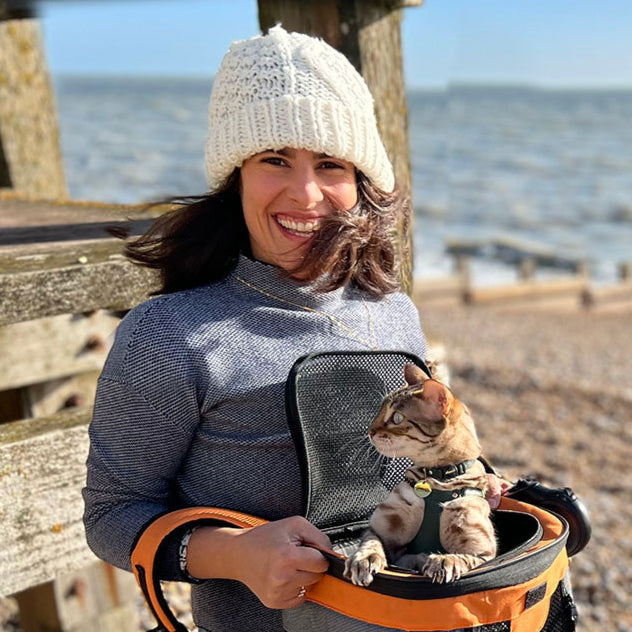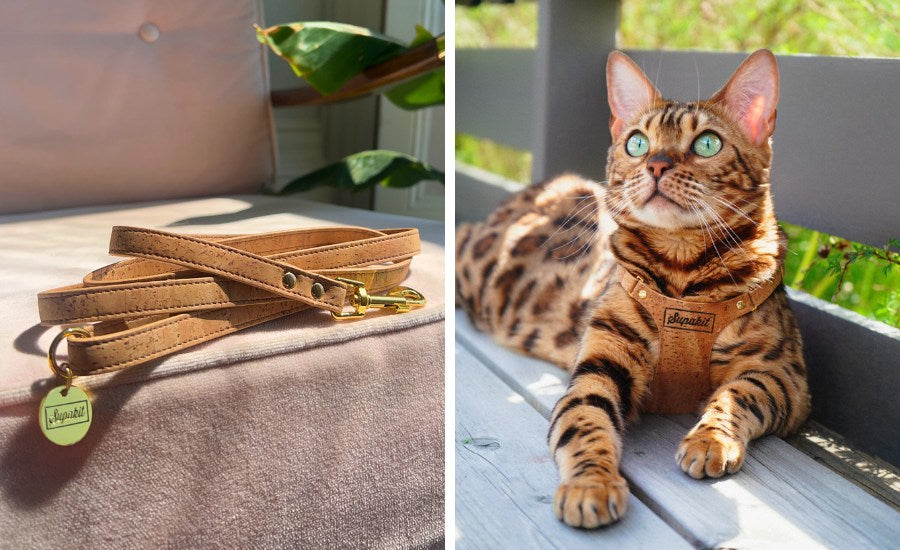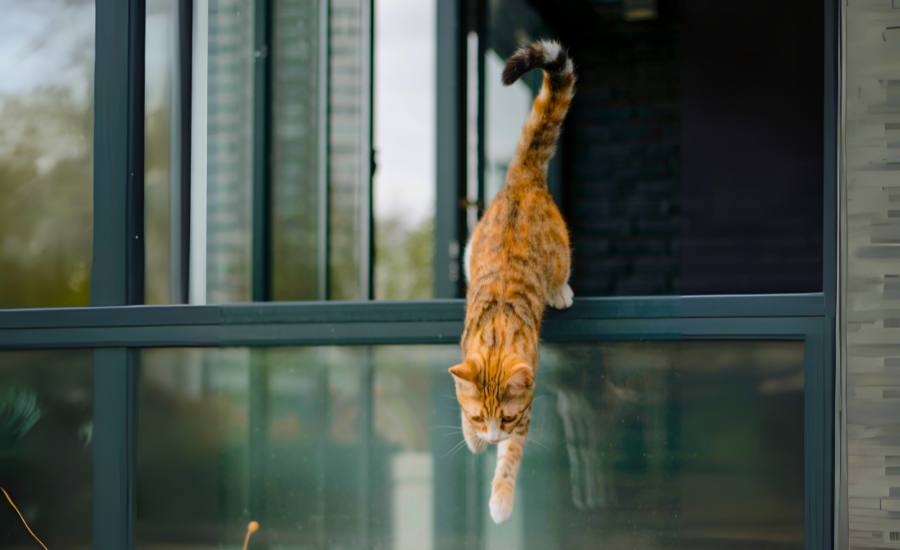Maintaining a Healthy Weight For Your Cat
We always love chatting to vet and friend of Supakit, Dr. Alex Avery from @ourpetshealth about all things cat! We welcomed Dr. Alex back to the Supakit monthly #catchat to talk about overweight cats and what we can do to help them lose those extra lb's!
First, let's remind ourselves why it's so awesome to chat to Dr. Alex! Working as a general practice vet since 2006, Dr. Alex Avery has treated countless cats for a whole host of ailments, diseases and behavioural issues. Alongside his busy practice, he also runs Our Pets Health, an online resource packed to the brim with amazing tips, tricks and invaluable information on how to care for your pets. If that wasn't enough, Dr. Alex is also the host of his podcast, Call the Vet. Check out the Supakit episode here!
Read on for our #catchat with Dr. Alex, or if you'd prefer, head over to watch the full interview on the Supakit IGTV channel!

Why are vets concerned about our cat’s weight and what are the risks associated with overweight cats?
Dr. Alex: We used to think that carrying a little bit too much weight wasn’t an issue, that a cat could be ‘chunky but healthy’ and that actually couldn’t be further from the truth. Fat is an incredibly active tissue and massively pro-inflammatory so it releases chemicals into the body, most of them cause inflammation and it affects the whole body.
We know that an overweight cat is specifically are at 3-5 times greater risk of developing diabetes and early on set arthritis. This is a particular problem as cats are so good at hiding their pain from us, early onset arthritis means they will be living with a significant amount of pain for a large proportion of their lives. Being overweight can also cause skin disease, urinary tract disease, kidney problems, liver disease – you name it, it contributes to it. So if we can keep our cats a healthy weight, we can go a long way to help prevent them suffering from these conditions.
Across the world, 60-75% of cats are overweight and that’s because our perception of a cat’s ‘normal’ weight is completely skewed. We’re used to seeing cats that are overweight and we think that’s how a cat should look. Owners often ask me if their cat is underweight, worrying that they’re not eating enough when in reality, their cat is actually overweight! We are just not recognising that our cats are overweight.

Should we be weighing our cats on a regular basis?
Dr. Alex: Yes, we can weigh our cats at home so we can keep a good track of our cat’s weight. It’s very easy to weigh a cat, you can place them in their bed or carrier and simply subtract the weight of the bed from the number on the bathroom scales. It’s also worth asking your vet what is the ideal weight for your cat so you have a baseline number to work to.
Vets also like to carry out a body condition score, a great resource online for this is the WSAVA body condition score. One marker for this score is being able to feel a cat’s ribs, without putting any pressure on their body, a thin layer of fat isn’t too much of an issue but you should be able to feel their ribs easily.
Another marker is to look at your cat from above and you should be able to see their waist, they should have an hourglass figure. Looking at your cat from the side, they should have a little bit of a waist visible, they certainly shouldn’t have a big fat pad dangling down. If you frequently follow these markers and your cat does begin to gain weight, you’ll notice that you can’t feel their ribs as much and looking from above and the side, they’ll start to fill out, lose their waist and become more rectangular in their body shape. A hidden area for weight gain on cats is the fat pad between their back legs, it might be tricky to feel this but if you can feel a handful of fat that’s a bit squidgy, that’s a sign that they’re likely carrying too much weight.
Keeping a regular track of their weight, aiming to keep at the weight that your vet has advised is healthy for their size and keeping an eye on their body condition will allow you to notice if their weight starts to creep up.

WSAVA - Download Body Condition Score here
That seems like a manageable way to keep on top of your cat’s weight without waiting until you are in the vet’s consulting room with them telling you that your cat is overweight.
Dr. Alex: As owners, we tend to show our love for our cats by feeding them, treating them to nice food, giving them a little bit extra because they might look like they’re hungry, it’s very easy to see how cats can become overweight. There may come a point where your vet has to be straight with you, use the ‘F’ word – that you have a fat cat. On occasion owners might take offense to this but it’s critical that you solve this problem together to prevent the whole host of problems in the future.
When it comes to weight loss for cats, we do need to be very careful, especially with those who are morbidly obese. They can suffer from a condition called ‘fatty liver’ or ‘Hepatic Lipidosis’ if we allow them to lose weight too quickly. The body goes into a starvation state and will attempt to mobilise fat within the body to use as energy. The processing of the fat is done in the liver but it won’t do this gradually, it will happen all at once. The blood will fill up with fat cells and the liver will do its best to process the fat but becomes completely overwhelmed, essentially becoming a big ball of fat and can’t function properly. When this happens, cats will go into acute liver failure that is absolutely fatal without significant treatment.
A course of action for weight loss if you have an obese cat is to work out a plan with your veterinary team, a lot of vet clinics will run weight loss programmes that are often free. A cat’s weight loss journey can be as long as 12 months which is a long time to be navigating by yourself, so your vet team will help you to track your cat’s weight and offer support and guidance.
If your cat is just slightly overweight, it is possible to help them at home without visiting your vet. There is a two pronged approach to weight loss in cats, the first would be diet and how we feed them, not just what we feed them, and the second is exercise. Dietary wise, they can stick to their normal diet but you can just reduce the amount by 10 of 15% and reweigh your cat regularly, if the weight is coming off then stick to that plan. Once your cat has reached a healthy weight, it’s likely that you can increase the amount of food slightly.
As a guide for feeding, we need to look on the packaging of our cat’s food and see what the recommended amount is for our cat’s ideal weight. We then need to reduce that amount by about 10 – 15%. Once they’ve reached their ideal weight, we can then feed them the amount stated on the pack for that particular weight range.
Just like us, cats have very different metabolic rates and will gain or lose weight quicker than others. I have a ‘Three M’ mantra that I like to use:
- Modify - reduce the amount of food they eat
- Measure - weigh them to see if their weight is coming down
- Maintain - continue to monitor their weight and adjust their food accordingly so they remain at their ideal weight
Weight loss it’s a dynamic process, your cat might lose some weight which allows them to become more active causing their weight loss to accelerate, in which case you might start to feed them a little bit more. So it’s important to always keep those ‘Three M’s’ in mind.
For those cats who are just a little bit overweight, that approach works really well - we know they’ve been a healthy weight but sometimes circumstances change, for example they may have gone to the cattery for two weeks and they’ve gained weight because they’ve been comfort eating. If it’s a longer term weight gain that has happened over years and their weight gain is significant, we may look at changing their diet. There are a number of ‘light’ foods available on the market, which usually means it is bulked out with a bit more fibre, so it keeps them fuller for longer and has less calories. Again, we can follow the packaging’s guide to feeding amounts and work from their ideal weight.
For cat’s who are significantly overweight or obese, the success rate for owners is not very high, as little as 20%. This is when I recommend a prescription diet, they are formulated specifically for weight loss and have lots of other ingredients such as L Carnitine which helps to mobilise and burn fat while maintaining muscle mass. Sometimes we find that cats can start to lose muscle mass when on a strict diet, which is something we absolutely don’t want, we want them to burn fat and maintain muscle. Some diets can even change the gene expression in the body to change a cat’s metabolism to one that burns fat and maintains muscle. The human version of this is called ‘The Mediterranean Diet’.

As owners, how can we make a cat’s transition to a new diet easier for them?
Dr Alex: If you’re just reducing the amount they eat then you can reduce it gradually so they get used to the smaller portions. A point to add here if you are simply reducing the amount you feed your cat, weigh it out – don’t simply do it by eye or by cups. The difference of a slightly heaped cup is potentially huge, it could be 20% extra that you’re feeding. To make the process of weighing out more time efficient, you can weigh out the amount you need for your cat’s meals for the week and divide it into 7 ziplock bags, then you’ll have premeasured portions ready to give your cat at each meal.
If you are transitioning your cat over to a completely new diet, this must be introduced slowly and there are several ways to do this. Firstly, you could mix a small amount of their new food in with their old, keeping in mind the correct amount you should be feeding in total.
Secondly, you could use their existing food bowl that they know, love and are happy to eat out of to feed their new food from, while offering them their old food in a new bowl, making sure the bowl itself is different to their existing bowl. The idea behind this is that they will naturally eat their new food first from their familiar bowl, while taking a few bites from their existing food, naturally allowing them to combine the two. I must say, I haven’t tried this approach and I always feed my own cats a mixture of different foods and each meal, that way they get used to eating different things.
Cats can become very focussed on one particular type of food, so they can become complete ‘kibble junkies’ or they will eat chunky cat food, but not the pâté. So giving them different textures and different flavours can be really beneficial if, at a later date, we have to change their diet for whatever reason.
How much should we focus on exercise for our cats if they’re overweight?
Dr. Alex: Exercise itself won’t help a cat to lose weight if we’re not changing what is in their food bowls, we must always start with their food if we want to help our cats lose weight. But exercise will help them to maintain and build their muscle mass. We can exercise our cats in a number of different ways; we can take them out for a walk in their harnesses and explore more with them.
We can also incorporate exercise into their feeding routine, rather than simply offering food in a bowl we can place food around the garden and allow them to hunt and find it. Or place it in bowls around the house so they have to physically go and look for it, this can also provide them with some great mental stimulation too. Potentially this is something we could be doing for our cats regardless of their weight as it provides great enrichment and mental stimulation for them.
We can also play with our cats more, if you’ve ever played with your cat using a simple rod and feather cat toy, you’ll know how puffed out they get! Laser toys are great for getting your cat moving, however, you have to be a little bit careful with laser toys as cats can become completely fixated on searching for the laser all of the time! Play can provide physical exercise and that mental stimulation as well as a great bonding experience with you and your cat.

As humans, when we’re bored we tend to eat, is this the same for cats?
Dr. Alex: Absolutely, alongside this never feed your cat ‘ad lib’ by leaving a bowl of biscuits down and topping it up when it looks a bit empty. If your cat is bored, they will graze from it all day. It’s an urban myth that cats will regulate their food intake, they will eat the food if it is left out for them. So help to control what they are eating by measuring out their portions and don’t top up the bowl throughout the day.
Related post: 'How To Keep Your Cat Happy At Home'
When you’re training a cat, it’s often advised to use food treats as a reward, should you subtract that from their daily food allowance?
Dr. Alex: Yes, ideally it will say on the back of the treat packet how many calories it contains, which might take some sitting down and working out how that factors into your cat’s daily food allowance. If it doesn’t have the calorie content on the packet, there may be a helpline to call where they can answer that question. I would suggest if no nutritional information at all is available to you for that particular food, it might not be a food that you should be giving to your cat.

For people that have multi cat households, how can you manage feeding cats with different dietary needs?
Dr. Alex: There are a number of different ways we can do that, the more animals there are in the house the harder it is to feed different diets. The way we can get most success is to use a microchip cat bowl, it scans your cat’s microchip and will only open up for that cat. They’re not cheap at around $150 or £75 approximately, but I would say that’s the easiest option with the most success.
If you’re going down that route and you have more than one cat, especially if one of those cats has a specific medical condition that requires a particular food, you’ll only need to buy one microchip feeder. Use the microchip bowl for the cat who is healthy or doesn’t require a specific diet, that way your cat that has the medical or dietary need only has access to their ‘safe’ food and it isn’t such an issue if your ‘healthy’ cat has a couple of bites of the prescription food. Of course, you can buy a microchip feeder for each of your cats but that could start to get expensive for a multi cat household!
Another option is to set mealtimes so your cat gets used to the time that they are fed, it might take a while for your cat to get used to a stricter feeding schedule, especially if they are used to grazing, but it will be worth it in the end when they learn that they only have twenty minutes or so to finish their meal. You can also use these feeding times to separate your cats and feed them in different rooms of the house, shutting the door and allowing each of them 20 to 30 minutes to finish their meal and then take away all food bowls so there is no chance of your cat eating something they shouldn’t. This method is rather dependent on how busy your life is and if you have the time to dedicate to this way of working.
It’s important that people don’t beat themselves up about the fact that their cat is overweight. Most cat owners have been there, including me. Cats usually gain weight very slowly, over a number of years and we see our cats every day so it’s difficult to notice. Cats also don’t often show that they’re struggling very clearly, so it’s very easy to miss. Weight loss isn’t an easy journey for anyone, cats included, so don’t feel bad if your cat isn’t making the progress you were hoping for, it’s great that you’re addressing the problem in the first place. If you are struggling to see results in your cat’s weight loss then talk to your vet and reach out. We, as vets, want our patients to be as healthy as possible and to prevent as many diseases as possible, that’s what we’re here for after all.
For more of Dr. Alex's advice on cat care, head over to www.ourpetshealth.com
Related post: 'What Have You Always Wanted To Ask A Vet? Dr Alex Avery'







